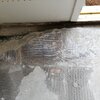Hi folks.
I am living in a terraced house built 13 years ago. I have been trying to make use of the lockdown to tackle some redecorating projects. I just started preparation for retiling the hall.
The old tiles came up without too much issue. After removing the tiles adjacent to the front door sill, I noticed some dampness and rot along the door sill. I removed some of the crumbling mortar between the sill and the internal concrete slab to inspect further.
Unfortunately I don’t know what I should be looking at but am concerned that the damp proof membrane doesn’t continue outside under the door sill. Should this be the case and is this the reason for the rot?
The rest of the door and frame appear to be in reasonable condition and ideally I would like to retain the door/frame to save money. Any suggestions really appreciated.

I am living in a terraced house built 13 years ago. I have been trying to make use of the lockdown to tackle some redecorating projects. I just started preparation for retiling the hall.
The old tiles came up without too much issue. After removing the tiles adjacent to the front door sill, I noticed some dampness and rot along the door sill. I removed some of the crumbling mortar between the sill and the internal concrete slab to inspect further.
Unfortunately I don’t know what I should be looking at but am concerned that the damp proof membrane doesn’t continue outside under the door sill. Should this be the case and is this the reason for the rot?
The rest of the door and frame appear to be in reasonable condition and ideally I would like to retain the door/frame to save money. Any suggestions really appreciated.












